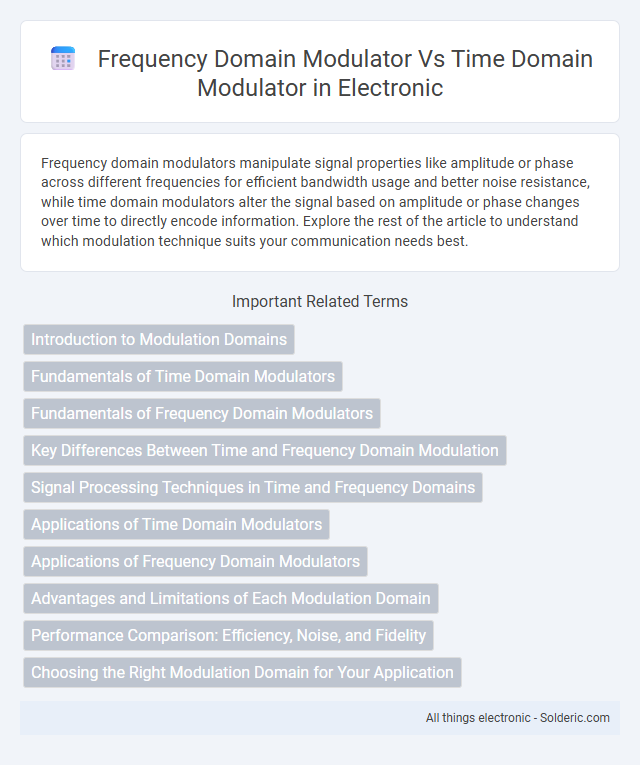Frequency domain modulators manipulate signal properties like amplitude or phase across different frequencies for efficient bandwidth usage and better noise resistance, while time domain modulators alter the signal based on amplitude or phase changes over time to directly encode information. Explore the rest of the article to understand which modulation technique suits your communication needs best.
Comparison Table
| Feature | Frequency Domain Modulator | Time Domain Modulator |
|---|---|---|
| Definition | Modulates signal by altering frequency components. | Modulates signal by changing amplitude or phase over time. |
| Modulation Type | Frequency modulation (FM), Phase modulation (PM) | Amplitude modulation (AM), Pulse modulation |
| Signal Representation | Frequency spectrum-based | Time waveform-based |
| Bandwidth Efficiency | Typically wider bandwidth usage | Potentially narrower bandwidth depending on method |
| Noise Immunity | High resistance to noise and interference | More susceptible to noise |
| Complexity | Higher implementation complexity | Lower complexity |
| Applications | Radio broadcasting, satellite communication | AM radio, simple communication systems |
Introduction to Modulation Domains
Frequency domain modulator techniques encode information by varying the signal's frequency components, enabling efficient bandwidth utilization and resilience to noise interference. Time domain modulators manipulate the amplitude, phase, or pulse width of signals directly over time, offering simplicity and real-time processing advantages. Understanding these modulation domains helps you select the optimal approach for specific communication system requirements and signal integrity.
Fundamentals of Time Domain Modulators
Time domain modulators directly manipulate the amplitude, phase, or frequency of a signal as it varies over time, enabling precise control of instantaneous signal characteristics. These modulators operate by altering the signal waveform in real-time, which is crucial for applications requiring minimal latency and high temporal resolution, such as pulse modulation and time-based multiplexing. Understanding sampling rates, signal discretization, and temporal aliasing is fundamental to designing efficient time domain modulators with optimal performance.
Fundamentals of Frequency Domain Modulators
Frequency domain modulators manipulate signal spectra by varying amplitude, frequency, or phase components within specific frequency bands, offering enhanced noise resilience and bandwidth efficiency compared to time domain modulators. Your communication system benefits from their capability to separate signals based on frequency, enabling simultaneous transmission without interference. Techniques like Orthogonal Frequency Division Multiplexing (OFDM) exemplify the fundamental principles of frequency domain modulation for high-speed data transfer.
Key Differences Between Time and Frequency Domain Modulation
Time domain modulation encodes information by varying the amplitude, frequency, or phase of a signal over time, directly manipulating signal waveforms. Frequency domain modulation represents signals as a combination of sinusoids at different frequencies, enabling modulation by altering frequency components or spectral properties. Key differences include that time domain modulation deals with signal changes over time, while frequency domain modulation focuses on signal representation and alteration in the spectral frequency components.
Signal Processing Techniques in Time and Frequency Domains
Frequency domain modulators manipulate signals by altering their spectral components, enabling efficient filtering and analysis of frequency-specific information essential in applications like OFDM and spread spectrum systems. Time domain modulators directly modify signal amplitude or phase over discrete time intervals, crucial for pulse shaping and maintaining temporal signal coherence. Understanding these signal processing techniques allows you to optimize communication systems by selecting the appropriate modulation method based on channel characteristics and performance requirements.
Applications of Time Domain Modulators
Time domain modulators are widely used in applications requiring real-time signal processing, such as digital communication systems, where rapid modulation and demodulation are critical for maintaining data integrity and minimizing latency. They play a crucial role in radar and sonar systems by allowing precise time-based manipulation of signals for accurate target detection and distance measurement. Your choice of a time domain modulator enhances performance in environments demanding high-speed, time-sensitive signal transformations.
Applications of Frequency Domain Modulators
Frequency domain modulators excel in applications such as wireless communications, radar systems, and signal processing where bandwidth efficiency and spectral analysis are critical. They enable precise manipulation of signal spectra, making them ideal for multiplexing, spread spectrum, and OFDM (Orthogonal Frequency Division Multiplexing) techniques used in advanced networking and broadcasting. Your ability to efficiently encode and transmit data relies heavily on frequency domain modulation for optimized channel utilization and interference reduction.
Advantages and Limitations of Each Modulation Domain
Frequency domain modulators excel in spectral efficiency, enabling the multiplexing of multiple signals over a shared medium with minimal interference, but they often require complex filters and precise frequency control, increasing implementation complexity. Time domain modulators offer simplicity and lower latency by directly manipulating signal amplitude, phase, or pulse width in the time intervals, yet they can suffer from bandwidth inefficiency and are more susceptible to noise and temporal distortions. Choosing between frequency and time domain modulation depends on application-specific needs such as channel conditions, system complexity, and desired signal robustness.
Performance Comparison: Efficiency, Noise, and Fidelity
Frequency domain modulators offer superior noise resilience and higher fidelity by processing signals in the spectral domain, allowing more precise filtering and interference mitigation compared to time domain modulators. Time domain modulators generally exhibit lower computational efficiency due to handling raw waveform amplitude changes directly, often resulting in increased susceptibility to noise and distortion in complex signal environments. Your choice between these modulators should balance efficiency requirements and signal fidelity goals, with frequency domain modulators preferred for applications demanding robust noise performance and high-quality signal reproduction.
Choosing the Right Modulation Domain for Your Application
Choosing the right modulation domain depends on your application's requirements for signal processing efficiency and noise resilience. Frequency domain modulators excel in handling complex signals with multiple frequency components, enabling precise filtering and spectral analysis. Time domain modulators offer simplicity and faster real-time processing, making them ideal for applications demanding low latency and straightforward implementation.
Frequency domain modulator vs time domain modulator Infographic

 solderic.com
solderic.com